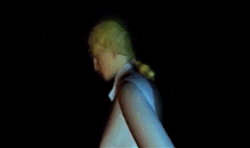
‘The technology of the ’90s, including innovations in 3D graphics and affordable storage in the form of CD-ROMs, opened doors for a new generation of video game innovators. One of them was Kenji Eno.
‘Eno’s games became known for their singular creativity, though they never managed to land major commercial success. But that was all part of what kept Eno going and inspired his fervent work ethic and indie-first mindset.
‘“Eno’s work serves as a lesson in overcoming hardship,” says John Andersen, a writer and video game historian. “Eno’s point-of-view was: Forget about the societal norms that you believe are blocking you. Bring your creativity out of the shadows and into the world.”
‘I have always found it fascinating that someone can be “ahead of their time.” In his two decades making games, Eno certainly proved to fit the bill. Nowadays, it is common to find walking simulators like Firewatch and What Remains of Edith Finch that position the narrative first—cinematic-driven experiences that zero in on oddity rather than rogue-like difficulty. Eno was first to explore this now accepted game design aesthetic. Still, his best-known game, D, is barely a footnote in video game history. Perhaps if he had been producing D today, the game and his work might have found even wider acceptance.
‘On March 1, 1994, Eno founded Warp, a game studio that would go on to produce his most recognized work. The studio was every bit a startup, with a limited staff and resources that would influence which platforms the studio focused development on. A few years before the original PlayStation launched and quickly dominated the marketplace, Tripp Hawkins, founder of Electronic Arts, left to start the 3DO Company. Among its largest feats was the 3DO Interactive Multiplayer, a 32-bit gaming console at the cutting edge with its use of CD technology and 3D polygonal graphics. Eno was attracted to how affordable it was to develop for the console. Using the 3DO’s technical capabilities, he aimed to develop an ambitious filmic game experience that would become 1995’s D.
‘At a time when “survival horror” was still months—or, in Resident Evil’s case, a year—away, Warp published the game. The story follows Laura Harris as she investigates a hospital after her father has a psychotic break, resulting in a mass-murdering spree (with a controversial side of cannibalism).
‘The game plays a bit like Myst. Every move the player makes is matched on screen with dramatic cinematic sequences. Coupled with an extremely ominous and moody soundtrack composed by Eno himself, D was a commercial success at the time, selling a million copies in its native Japan and becoming a system seller on the 3DO. In the States, it became a cult classic, launching Eno’s name into the stratosphere of the gaming public.
‘“What I respected most about Eno was that he wanted a better working environment for Japanese game developers,” Andersen says. “He had seen how American game developers operated in the early-to-mid 1990s; he wanted the same environment for Japanese game developers.”
‘While American developers like John Romero and John Carmack of id Software stepped into the spotlight, speaking out for their games openly and with definable charisma, Japanese game companies were highly structured and culturally devoid of interaction with their audience. Japanese developers seldom looked past their current projects and treated each game as work to be done, moving on without any participation in the title’s marketing or publicity. Eno wanted Japanese developers to be more like rockstars. “He was a very outspoken guy, which is why he chose to strike out on his own.” …
‘During his last years, Eno endured a period of creative wanderlust, his artistic drive extending across multiple mediums, including writing a children’s book called Dear Son and the proposed founding of a school dedicated to the arts and entertainment media. Until his death on February 20, 2013, due to heart failure at the age of 42, he never stopped working. Katsutoshi Eguchi, a developer and composer at Warp, told Gamasutra: “He went to America about two days before he died. As soon he touched back down in Japan, he went to his office to work. He didn’t even go home on weekends; he just worked straight through. He never rested.”
‘Eno left a unique mark on gaming, one that is frequently eclipsed by the efforts of more popular game developers, even though his oeuvre is held close and remembered affectionately by a devoted fanbase of hardcore gamers. “He was able to plant seeds in people’s minds, to get them thinking,” Harmon muses. Should you happen to experience one of his games, you too might fathom the full extent of his vision.’ — Michael Seidlinger, Wired (read the entirety)
___
Stills

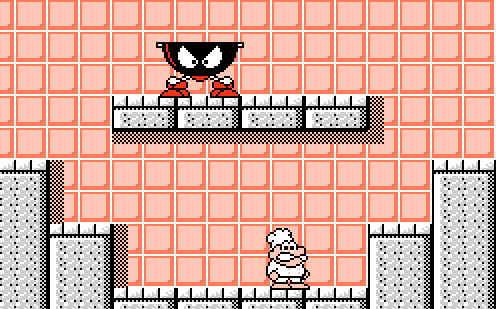
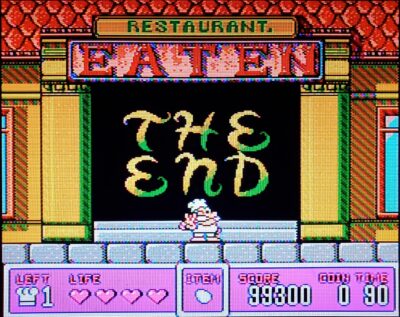


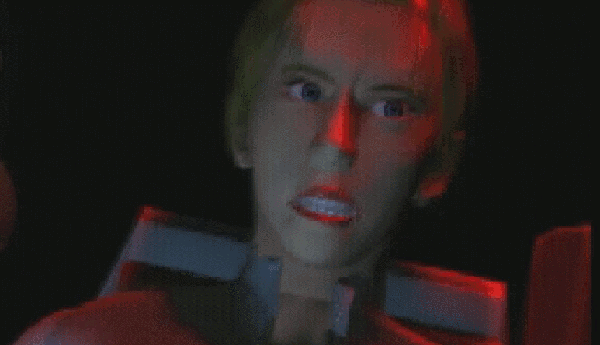

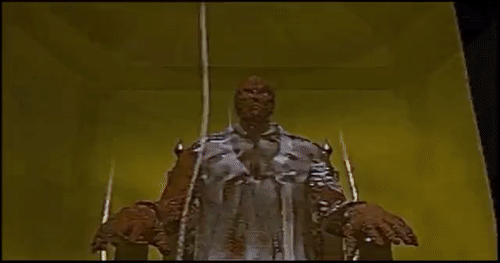
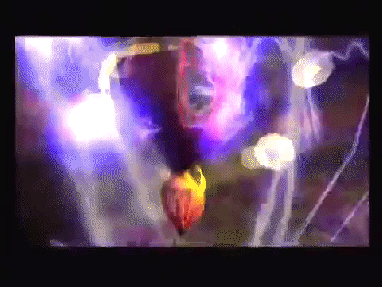
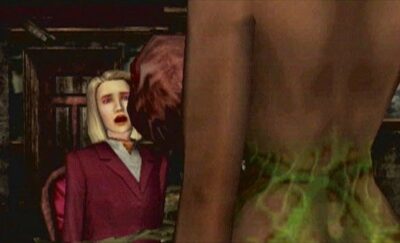
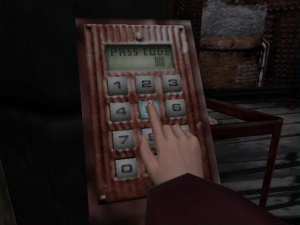
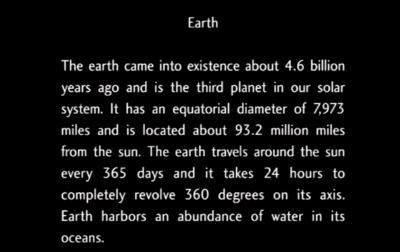
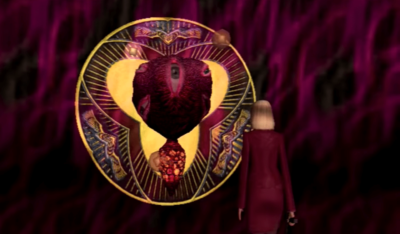
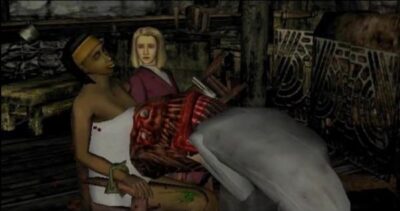
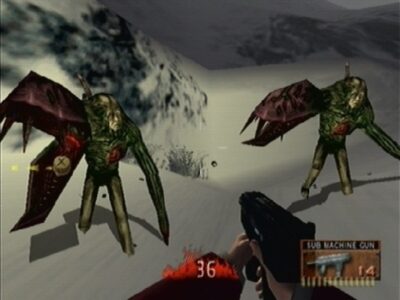

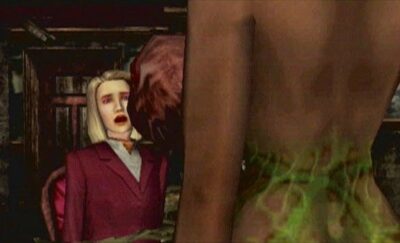
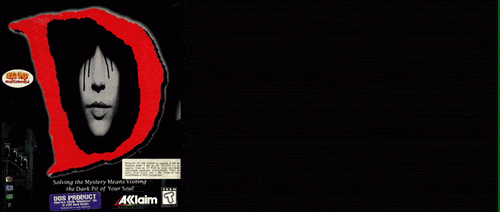

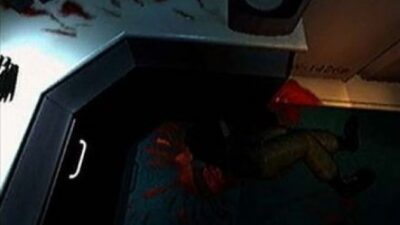
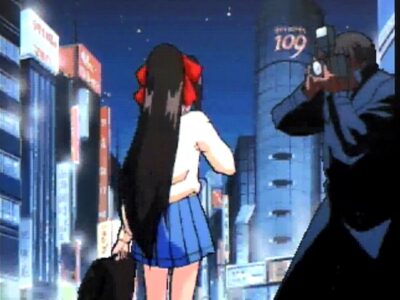



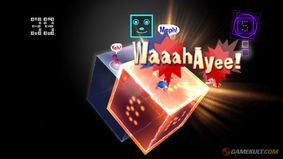
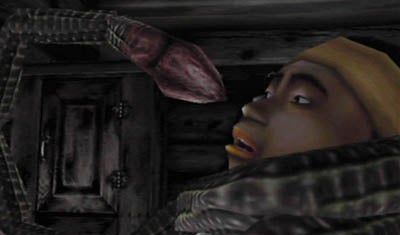

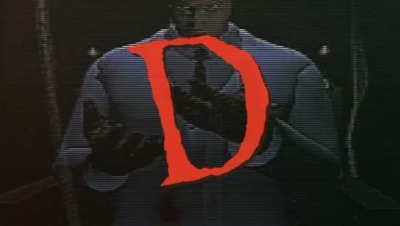


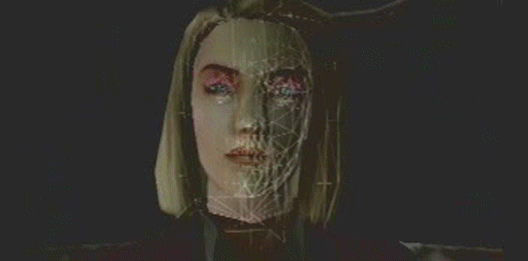

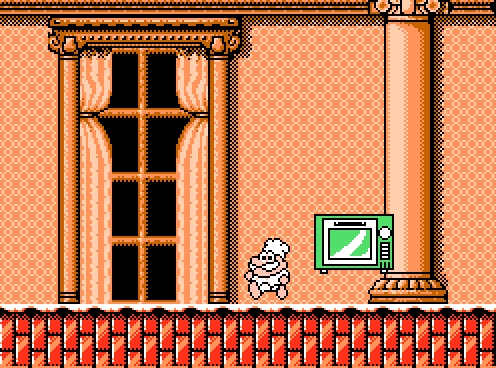


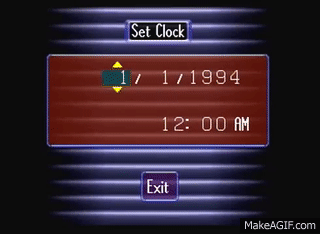


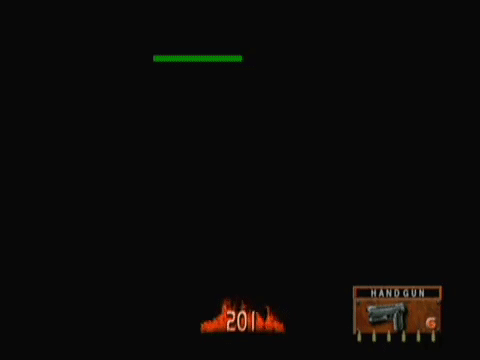
_____
Further
Kenji Eno @ Wikipedia
KE @ Giant Bomb
Kenji Eno Broke New Ground for Video Games
Remembering Kenji Eno
Kenji Eno Passed Away, But His Friends Are Making His Last Game
THE NEGLECTED HISTORY OF VIDEOGAMES FOR THE BLIND
Kenji Eno: Reclusive Japanese Game Creator Breaks His Silence
Memories of Kenji Eno
The Elusive Kenji Eno Speaks!
D – Kenji Eno’s Breakthrough Horror-fest
BitSummit’s Tribute To Kenji Eno
The “D Trilogy” Was Weird, Wild, and Truly One-of-a-Kind
Interview with Kenji Eno
____
Extras
Kenji Eno Who Dreamed in 3-D
Trolling Sony, Tricking the ESRB, and Horror Games: A Kenji Eno Story
One Man & His Machine
Kenji Eno promote D2 for SEGA Dreamcast on TGS ’99
____
Interview


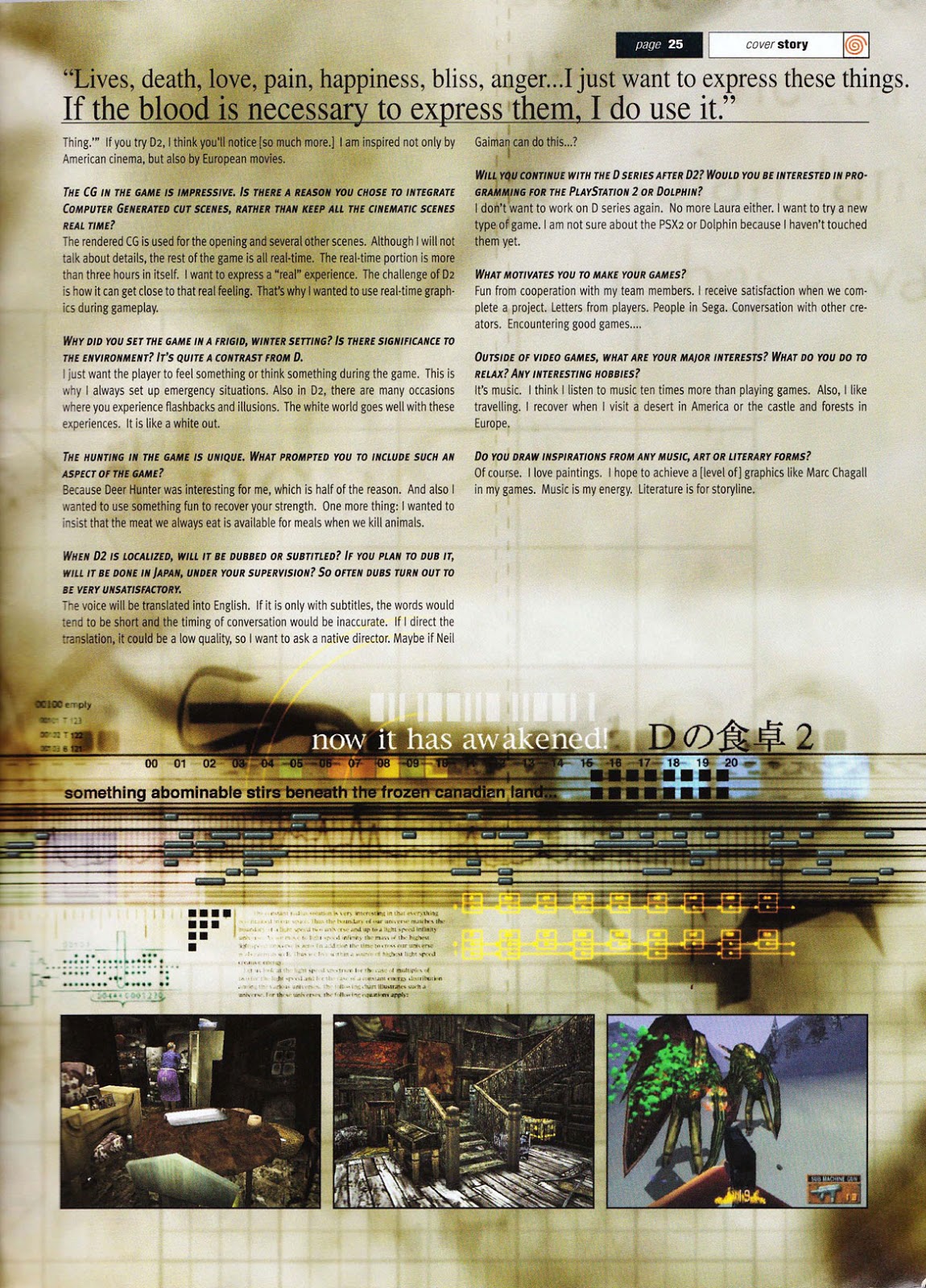
____
Games
_____________
Time Zone, 1991
_____________
Panic Restaurant, 1992
‘Known in Japan as Wanpaku Kokkun no Gourmet World (“Panic Kokkun’s Gourmet World”), Panic Restaurant is the brainchild of the late Kenji Eno, the eccentric musician/game designer behind the D survival horror series. Don’t expect anything so avant-garde here, though. Panic Restaurant is about as basic as 8-bit side-scrollers get, relying almost entirely on its quirky theme and vivid cartoon graphics to make an impression. The player controls an elderly chef named Cookie on a quest to reclaim his stolen restaurant from scheming rival Ohdove (an unfortunate mangling of “hors d’oeuvre”). Cookie’s expressive sprite art and animations make him a likable protagonist. I appreciate Ohdove, too. He’s a scrawny weirdo with that manic Waluigi energy.’ — collaxx
___________
Sunman, 1992
‘EIM would also be contracted by Sunsoft to create a Superman video game for the NES. However, due to conflicts with design, the game was cancelled. Sunsoft then asked the company to create another superhero based gamed entitled Sun Man. While the game was never officially released, a seemingly complete version would resurface on the Internet many years later.’ — collaxxx
__________
Flopon: The Space Mutant, 1994
”The First game Kenji Eno made for the 3DO was a puzzle game called “Flopon The Space Mutant”. It was a huge hit in Japan and as a promo for the Playstation version ( Flopon P ) there was even a TV game show where contestants played the game against each other for prizes. There was a rap song based on the game ( The Flopon Rap ) and dolls, t-shirts, pillow cases, bed sheets….you name it. At the time, you probably couldn’t go anywhere in Japan without seeing the mascot Flopon (the character with the bat wings) on billboards, store windows etc.’ — LightningBoy
__________
Trip’d, 1995
‘Unlike “Tetris”, “Columns” and other similar puzzle games, “Trip’D” has a unique twist in which you form 4 eggs in a square and create a alien creature. You then need to get 4 or more of the same egg to make contact with each other to get rid of the alien. In doing so, you get a bonus of extra points or the removal of 1 or more layers of eggs that start forming at the bottom of the screen. As with all games of this type, if the eggs get to the top of the screen, it’s GAME OVER!. This makes for some interesting strategy espeacially when playing against another person. You can make layers of eggs drop down on your enemy or make aliens drop down on your enemy. When your enemy gets rid of the aliens that you drop, it makes more eggs drop down on him/her. This might sound simple, but it’s not.’ — LightningBoy
_____________
Oyaji Hunter Mahjong, 1995
‘Our story begins as a high school girl walks home alone at night, only to be assaulted by a pervert who flashes her with his camera and begs for her underwear. Then he flashes himself, revealing he’s wearing nothing but pink teddy bear panties. Clearly in a pinch, she calls for the Oyaji Hunter! Alright, so to get this in the right order: the pervert is tazed, then Hunter flies in from miles away and punches him to the ground. I’m not sure how he shocked him from a mile away, but I have to admit he’s good at stopping an attack in progress. The best part of all these scenes is the obviously forced segue into mahjong.’ — kusoge.cafe
___
D, 1995
‘D‘s premise is very simple. The player is given two hours real time to navigate the castle, solve puzzles, and locate Richter. Much like the classic Dragon’s Lair, you’re simply pressing directional buttons to move Laura around, and hitting a button to make her interact with the environment or examine her inventory. If you get to a puzzle that has you stumped, Laura can consult her mystical compact for clues. However, you can only do this three times before the compact mirror shatters and becomes useless for the rest of the game.
‘While dated by today’s standards, D earned a great deal of attention back in the 90’s for it’s slick pre-rendered presentation, moody and omniprescent atmosphere, and it’s somewhat gory subject matter for the time. Indeed, Kenji was concerned that the game wouldn’t be published in the US as a result, and came up with a rather devious scheme to ensure it would see the light of day Stateside. During it’s initial development, there was no narrative attached to the project. The story was created in secret, and most of the WARP staff wasn’t even aware it existed. When everything was finished, Eno submitted this ‘clean’ version of the game for approval. Since he had submitted the master discs late, he would have to hand deliver the final product to the US manufacturers if he wanted it published. This was all part of Kenji’s plan. While on the plane bound for America, Kenji channeled the spirit of Folger’s coffee commercials, and switched out the ‘clean’ version with the complete copy. As a result, Kenji was able to completely bypass the censors. Clever girl.
‘While D made little impact in the States (much in part to the 3DO’s low user base at the time,) it was well received in Japan. So much that WARP would produce a “Director’s Cut” of the game in 1998, featuring new footage, interviews, and all kinds of neat goodies. However, Acclaim took a liking to WARP’s little creation, and offered to publish the game for Sony and Sega’s 32-bit systems, as well as PC’s running Microsoft Windows and DOS. This helped D gain more exposure in the US and Europe, and led to even more sales for Eno and his crew. However, this move would result in Eno having a huge fallout with Sony and it’s Playstation brand.’ — The Pigeon Coop
_______
Short Warp, 1996
‘Another Japan only WARP release was one of their most bizarre yet. Short WARP was a series of eight crazy mini games. And I do mean crazy. Take a look at the vid above if you don’t believe me. And get this: inside every copy of the 10,000 hand numbered units produced, Kenji Eno was gracious enough to include a very special WARP condom. Yep…a condom. No dumb art books or soundtracks. Just pure protected sexual bliss. What a guy!’ — The Pigeon Coop
_____________
Real Sound: Kaze no Regret, 1997
‘Real Sound: Kaze no Regret (“The Wind’s Regret”) is an audio game released for the Sega Saturn by Japanese studio WARP, Inc. and directed and produced by the company’s founder Kenji Eno. The game was released on June 15, 1997. The game was re-released for the Dreamcast in 1999 with a visual mode that included pictures and photos to accompany the story, but this version of the game also relies entirely upon sound and audio cues for gameplay.
‘The game came as a result of contact that Eno had with blind and visually impaired fans of WARP games. Eno was fascinated that the visually impaired would be fans of his games. He thought his games were very visually rich. He even went so far as to contact some of these fans to find out how they played his games if they could not see the games. As a result Eno decided to make a game that would be audio only, with no graphics at all.
‘Real Sound: Kaze no Regret was a very large influence on further games from Kenji Eno and WARP, Inc. Games that came afterward from the company would take gameplay elements from Real Sound. Enemy Zero featured invisible enemies that could only be through sound. D2, also from WARP, included parts of the game where the player’s character was rendered blind and the player must rely on sound, following a voice to get through the game. D2 also featured a sequence where the character was rendered deaf.’ — Giant Bomb
_________
Enemy Zero, 1998
‘Enemy Zero was originally planned to be a PlayStation-exclusive game, however designer and founder of Warp, Kenji Eno took a strong dislike to Sony’s manufacturing process, failing to prioritise copies of his previous game, D. Though Acclaim, D had amassed roughly 100,000 pre-orders, however Sony only produced 28,000 copies of the game in time for release.
‘This friction led to one of the most interesting headlines of 1996, in which during a backroom conference at the 1996 PlayStation Expo promoting a game with strong public backing from Sony, a PlayStation logo at the end of an Enemy Zero morphed into a Sega Saturn one, with Eno proceeding to jump on a stuffed MuuMuu from the Sony-published PlayStation Jumping Flash!.
‘Following this incident, all Warp-published games became Sega exclusives, starting with this game and continuing with both the Saturn and Dreamcast versions of Real Sound: Kaze no Regret and finally D-2 (the studio being closed shortly afterwards).’ — segaretro
___
D2, 1999
‘D2 is arguably the weirdest game in Eno’s exceptionally strange trilogy and only takes the series to more insane places. This is a title where during one boss fight a giant pigeon will swoop in to momentarily eat your enemy’s entrails. There’s also lots of validation for tentacle porn fetishists in this game and it really earns its MA rating, so proceed with the proper amount of caution.
‘D2 was originally planned to take the series back to its roots at Panasonic for their new M2 console, the cancelled follow-up to the 3DO. D2 drastically changed when it headed over to the Dreamcast (although a trailer for the original game for the M2 version was still shown at 1997’s Tokyo Game Show and can be found hidden away in the Japanese release of D2). Eno also continued his streak with weird marketing in order to publicize the game, like when he simply held a celebration for the arrival of the cherry blossom rather than feature any game demos.
‘There are echoes of both of Eno’s first two games in this title (Kimberly from Enemy Zero even sticks around), even though this game once again tells a totally new story with a new version of Laura. If Enemy Zero is Kenji Eno riffing on the Alien franchise, then D2 is his tribute to The Thing and fellow body horror classics.’ — Bloody Disgusting
____________
You, Me, and the Cubes, 2009
‘A little background info- the concept, design, and music of You, Me and the Cubes are all by Kenji Eno, the creator of the some of the most interesting games on the Dreamcast and Sega Saturn. He’s also a well renowned Sony-hater, is rumored to suffer from mental illness, and hasn’t released a game on a home console in over nine years. You, Me and the Cubes marks Eno’s triumphant return to the gaming scene, and what a weird triumph it is.
‘The game can be enjoyed on many levels. Some will see it as just a 1 or 2 player puzzle game, others will see it as a creepy take on the afterlife, still others will view it as a opportunity for run-of-the-mill sadism on a big cloudy cube. Personally, I see it as a game about parenting, and how scary and awful that responsibility can be. Regardless of what you make of the game, it is unquestionably unique and well made. It’s not all greatness. There are a few parts of the game that are downright ugly, but for the most part, You, Me and the Cubes is an elegant work of art.’ — Destructoid
_______
Kakexun, ?
‘Kenji Eno, the famed Japanese developer behind such esoteric titles as D, D2, Enemy Zero, and You, Me and the Cubes may have passed away in February 2013 at age 42, but the brilliant and eccentric game designer wasn’t going to let that stop his final project, Kakexun, from seeing the light of day.
‘Instead, his developer colleagues decided to carry on his work to the best of their abilities. Kakexun launched a crowdfunding campaign earlier this year where it raised ¥5,486,300 (about £30K / $47K) for an alpha, and now it’s launched an Indiegogo campaign in the west to see the the game through to its beta.
‘The Kakexun project was initially launched by chief director Kazutoshi Iida, creative director Naoya Sato, and the producer Katsutoshi Eguchi. As one would expect of Eno’s work, Kakexun sounds weird. Really weird.’ — Eurogamer
*
p.s. Hey. ** David, Hi. Huh, the Ken Russell thing, wow. I avoid dentists like the plague until I’m, like, screaming in pain. But then it’s like no big deal. ‘Vivarium’, no, I don’t know it. But of course I’ll investigate. I don’t think I’ve ever screamed in my whole life. I’ve always thought screaming is one of those things that nobody ever actually does. ** Misanthrope, I’ve never owned gun either, duh. Oh, wait, when my dad died he left me a bunch of stuff including some ceremonial gun he was given when he was the President of the Junior Chamber of Commerce. I don’t know if it works. It doesn’t look like it does, but then … Alex Baldwin. Bowling! I love bowling. Haven’t gone bowling in ages. Do you know (or care) that there’s a bowling alley right underneath the Arc de Triomphe? Zac accidentally discovered that recently. It has a semi-secret entrance. I think we’re gonna bowl there. ** Dominik, Hi!!! Me too, big time! Yes, my yesterday love had a good soul. I don’t know where it came from, ha ha. Oh, hm, I guess I would ask your love to give me that Candy Machine gun, and thank you in theory. Speaking of yesterday, here’s today’s love who has found himself alone in a room with the cutest, most heterosexual boy he has ever seen, G. ** Sypha, ‘Darjeeling Limited’ would be in the lower rungs of my Anderson list. If the movie rights to your brother’s novel are ever purchased, the intended movie would need to have a 300 million dollar budget, I reckon. ** _Black_Acrylic, I shot a rifle at a shooting range as a teenager once. Otherwise, the only other times I’ve seen a real gun is twice, once pointed at my face when I accidentally wandered into a robbery at a 7-11, and the other time pointed at my head again as a teenager when a guy I picked up hitchhiking kidnapped me and my parents’ car and forced me to take him and his friends on a 10 hour, drug-fuelled joyride. Irvine wrote a TV series? Oh, the hellish doomed ARTE TV series thing … it got adapted (by Zac and me) into a film script which Gisele is supposedly shopping around. ** L@rst, Cool that you’re on board about ‘Fargo’. Like the Coens films too. I don’t I’ve ever disliked one, and several are killer. Man, do try to stick to the no smoking thing if you can. Well, I mean duh. Quitting is so fucking hard. I don’t even want to try again. But, man, huge, huge boon if you can do it. ** David Ehrenstein, Ah, excellent add. Everyone, Mr. E added to the guns post yesterday by linking us all up to a film by the great Jonas Mekas called ‘Guns of the Trees’ (1961). I similarly recommend its excellence. ** Steve Erickson, Hi. I really don’t anticipate writing non-fiction again. And writing about Bresson would be the last thing that would tempt me back. That’s way, way too hard an assignment for me. Everyone, Steve has a new song that you can hear: ‘Altamira’. ** Brian, Hey, Brian. Ghosting is one of the worst weapons people can use, up there with guns in a weird way. Like committing suicide out of spite for someone but without the death part. Or something. Anyway, you’ll live and well. Gotcha on the leaving so soon thing. And, yeah, no doubt it’ll all crystallise when it’s memory/fodder. I like ‘Trial of Joan of Arc’, obviously, but, yeah, it’s not one you would point Bresson novices at. ‘American Psycho’ is a great novel. It gets a lot of uncalled for poop, as do Bret’s other books, but it’s really something. I’ll watch ‘Titane’ this weekend for sure. It’s on deck, and I’ll let you know. Cookies and cake sound splendid, thank you. Maybe I’ll actually nudge your wished for Friday into being on my own. I hope your Friday sings ‘For He’s a Jolly Good Fellow’ to you until you tell it, ‘Thank you but please stop now.’ ** Okay. I came across the article I use at the top of this post by Michael Seidlinger the other day, and it reminded me of what a wacky video game auteur and pioneer Kenji Eno was, and I thought I would plant his work in front of you and see what happened. See you tomorrow.




 Now available in North America
Now available in North America 
you have screamed I bet ya!!!!!!!! ha!!!! that time you found a euro on the street…. everytime sonic youth released a new tune… and the time you realised you had successfully written a book that went on sale in stores all over the world… and that people really liked what you had written…. and of course some didn’t… I was living in a bedsit once and in full throng of chatting to my pal Lindley I spotted a face at the corner of the window.. it was very dark… I couldn’t get my words out to tell him so I grabbed his arm and tried to show him… I then ran out with a knife…. but no one was there…. another time I was jacking off sitting on a chair as you did back in the very late 90s… for hours and hours… the 6 or 7 hour wank culminating in a fanatic vomiting of the devils third hoop… in full throng 5 hours in… I looked back at the curtain covering the door and this fucked up orange face thing was right there looking at me!!!!… I screamed the place down…. turns out it was my pal poking a large ‘zippy doll’ from the british tv series ‘rainbow’ through waiting for me to spot it… I had to stop and have a cup of tea after that and then re start….
These computer graphics are brilliant… I had a ZX Spectrum back in the day I loved it…. also had a sega megadrive and later on a play station… oh and then there was the ‘wide screen Dahmer’ this contraption that cooked irritating tv personalities every time you pressed a button on the dooter…. ‘I wish’
‘Vivarium’ is well worth watching…. it’s about a young couple who want to buy a house and they get trapped in this world and are forced to bring up a baby boy that grows up very quickly…
Two highly creative Enos in one lifetime. What a treat!
Man, I haven’t played ANY of these… though I do recall that Panic Restaurant was featured in an old issue of NINTENDO POWER magazine.
I guess what I like about DARJEELING LIMITED is that it reminds me of the road trips my brothers and I used to go on when we were younger (though with our parents, and in less exotic settings), and how after awhile being in such close proximity gives rise to little annoyances that blow out of proportion.
A 300 million dollar budget? Nah, not that much… there’s not a great deal of characters, very little action (so far)… I guess it could cost a bit to shoot at Fenway, and the bridge-between-worlds could probably mainly be done with CGI. Well, last night I blew through some of the shorter chapters of Part Two. Essentially, at this point the main character (Ryan) has 24 hours to live. He and Naomi go to Pittsburgh and say goodbye to Ryan’s mother. They then go to the farmhouse where Ryan’s writer dad used to live, and where the bridge is located. That night Ryan confesses to Naomi his plan to wake up before she does and destroy the bridge, thus preventing her from her suicidal mission. They argue a bit, then they kiss and have sex. Ryan then tells her he’ll be dying the next day. But when he wakes up, he sees that Naomi is gone and he realizes that while he slept she went onto the bridge and through the door, back to her homeworld. When he goes to the door, he finds that it’s locked and there’s no way to follow her, and he has less than 2 hours to live. At this point there’s only 2 chapters (plus an epilogue) left, so the end is nigh…
Hi!!
Oh my god, poor love seems pretty upset, and I’m sure it’s not a candy gun in his hand! Love standing in front of yours, staring at the gun in shock, and not understanding what’s happening one bit – surely, he could offer something to this angry boy to ease his mind a bit, maybe let him touch his girlfriend’s boobs, Od.
Your gun stories really something. Might the 10 hour, drug-fuelled joyride have informed your creative process in some way? Like maybe you’d be writing children’s books otherwise.
That Irvine Welsh TV show Crime was a bit conventional but I’ll stick with it for now. Mum bailed after about 2 minutes because she just couldn’t understand the Edinburgh accents.
Really hoping The Ventriloquists Convention (if that’s still what it is?) might still see the light of day somehow.
KYLE RITTENHOUSE ACQUITTED OF ALL CHARGES !
I HOPE THE FAMILIES OF HIS VICTIMES CONTRACT A HIT!
Needless to say on hearing the verdict Kyle Cried!
Dennis has written monst eloquentlyon Bresson in a cahpbook entitled “AntoinneMonnier” — tha tDennis being Dennis he d0esn’t like. I TREASUREMY COPY
I don’t play a lot of video games (online chess doesn’t count, haha), but some of Eno’s work looks bizarre and irresistible. Will definitely check out the clips.
(I keep imagining a Brian and Kenji Eno collaboration, heh.)
Watched William Jones’ Finished. Very nice. Now if only I can find a copy of Tearoom or Fall of Communism…
The Rittenhouse outcome is terrible. But I can’t say it was a surprise after all the recent trial news.
Bill
Happiness is a Warm Kyle
Hello Dennis!!
Thank you for this day! Kenji Eno looks great, I didn’t know him and his work, but now I have to play these video games soon. Lately I’ve been playing ‘I Have No Mouth, and I Must Scream’ and I think it’s awesome, as a game and as interactive narrative, art or whatever. I think Harlan Ellison was involved in the project from start to finish, very weird game, have you ever played it? I hope all is super great with you!!
Hey, Dennis,
We’ve probably spoken about this before but, as posts like this always remind me, I really need to get into video games. All of these look so great. Not sure how accessible Eno’s older games are in the States anymore but, if I find one, maybe I’ll give it a whirl. I’d say you’re almost being too hard on ghosting, but, recalling how completely and abjectly shitty I felt over the situation only a few weeks ago, I’m inclined to agree. “Trial of Joan of Arc” was very special: a day later I actually think it’s one of the more satisfying and thought-provoking experiences I’ve had with his movies, although it does feel like a more minor work. I love the strange voyeurism he’s playing with in that movie. Will have to see how Dreyer’s take compares. I did quite love Ellis’ novel. The whole…voice was something else. It was interesting reading it after having been saturated in its many pop cultural offshoots for a while now, a weird sort of uncanny valley type experience. I definitely want to read more of his stuff now, “Glamorama” especially. Sometime next year for sure, after the current project of finishing Hervé Guibert’s diaries, and then Hardy’s “Jude the Obscure”. My Friday didn’t give me a single “For He’s a Jolly Good Fellow”, just a geology test, but I did get to watch “Farewell My Concubine”, which, for a movie that was apparently really lauded at the time, I was surprised to have heard so little about (I only found out about it through a friend). I thought it was very well-done, but I’m a bit of a sucker for melodrama on that scale (melodrama in general), so my judgement may be skewed. A pleasant enough day, then, except for the habitual American news blues, which depressed me as usual, but I don’t even know what to say about it at this point. This weekend is fortunately stacked: tomorrow, a 35mm screening of “Fox and His Friends” followed by a Thanksgiving thing my dorm is doing; on Sunday, boy oh boy, a double feature of Fellini’s “Satyricon” and “Toby Dammit” at the Museum of the Moving Image. Sometimes I really feel very lucky to live where I do. As for your own weekend, may all of Paris greet you warmly with some exuberant song-and-dance routine, like you’ve wandered into a Jacques Demy movie. Or, if that’s not your scene, rest and relaxation, or anything in between. Good things, in any case.